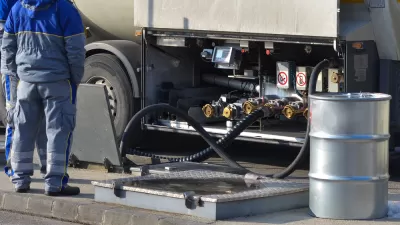Op-ed: Charging road users by how much they drive, not how much gas they buy, is the only sustainable way forward for infrastructure funding.

Earlier this year, President Biden called for electrifying the entire federal vehicle fleet — about 645,000 passenger cars, trucks and vans — putting the nation on track to a green energy transportation future.
General Motors followed shortly after, announcing plans to only produce all-electric vehicles (EVs) by 2035. Several other major automakers either plan to or have already produced EV models, joining Tesla, which has dominated the market for over a decade.
That’s the good news. The bad news? We need to find a way to pay for the repair and maintenance of our roads, bridges and public transit—which all rely in part on gas tax revenues—once we fully transition away from gas-powered vehicles.
Demand for EVs in the U.S. is expected to grow, accounting for a projected 7.6 percent of the passenger car market in 2026, up from just 1.2 percent in 2018. While new EVs are more expensive than conventional vehicles, prices will fall as they become less costly to produce. Federal and state governments also offer a range of consumer incentives such as tax credits, cash rebates and reduced registration fees to boost sales.
In addition to becoming more affordable to purchase, demand for EVs is certain to rise further as drivers become more aware of the money they could save on fuel and routine maintenance.
The growing demand for EVs and U.S. automakers’ production decisions may also reflect a shift in attitude on climate change among Americans. A Pew poll last year found that almost two-thirds of Americans said that protecting the environment should be a priority for the federal government compared to 41 percent in 2008. EV adoption will go a long way towards reducing environmentally harmful carbon emissions, as transportation accounts for almost a third of total emissions, the largest share of any economic sector in the U.S.
But as more drivers ditch their combustion engine cars for the electric equivalent, concerns are rising that revenues in the Highway Trust Fund, a dedicated source of money from the federal gas tax charged at the pump, will further erode. Because the tax has not been raised since 1993 and fuel efficient vehicles have increased in popularity, there has been a growing gap between the money needed to maintain our roads and the amount raised through the Fund. Since 2008, Congress has had to rely on annual transfers from non-dedicated revenue sources to prevent the Highway Trust Fund from running out of money.
With the gas tax becoming more unreliable as a revenue source and EVs on the horizon, most experts now agree that something needs to be done: the question is, what?
FULL STORY: Gas Taxes Pay For Our Roads. What Happens When Cars Go Electric?

Maui's Vacation Rental Debate Turns Ugly
Verbal attacks, misinformation campaigns and fistfights plague a high-stakes debate to convert thousands of vacation rentals into long-term housing.

Planetizen Federal Action Tracker
A weekly monitor of how Trump’s orders and actions are impacting planners and planning in America.

In Urban Planning, AI Prompting Could be the New Design Thinking
Creativity has long been key to great urban design. What if we see AI as our new creative partner?

King County Supportive Housing Program Offers Hope for Unhoused Residents
The county is taking a ‘Housing First’ approach that prioritizes getting people into housing, then offering wraparound supportive services.

Researchers Use AI to Get Clearer Picture of US Housing
Analysts are using artificial intelligence to supercharge their research by allowing them to comb through data faster. Though these AI tools can be error prone, they save time and housing researchers are optimistic about the future.

Making Shared Micromobility More Inclusive
Cities and shared mobility system operators can do more to include people with disabilities in planning and operations, per a new report.
Urban Design for Planners 1: Software Tools
This six-course series explores essential urban design concepts using open source software and equips planners with the tools they need to participate fully in the urban design process.
Planning for Universal Design
Learn the tools for implementing Universal Design in planning regulations.
planning NEXT
Appalachian Highlands Housing Partners
Mpact (founded as Rail~Volution)
City of Camden Redevelopment Agency
City of Astoria
City of Portland
City of Laramie




























